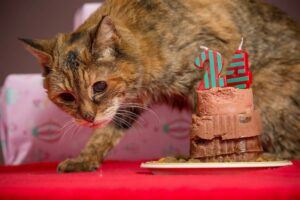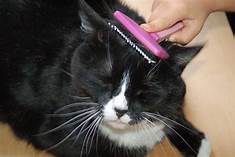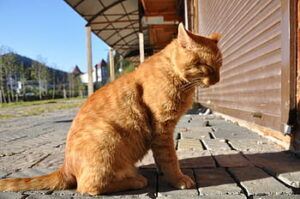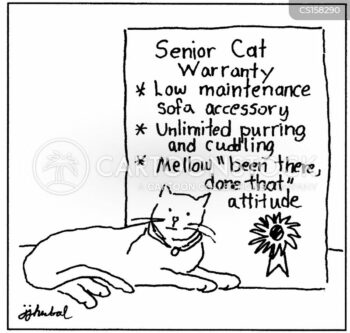Recently my good friend, Kate, gave me a great cat book. It’s called “The Cat Repair Book,” by Ruth B. James, DVM. It’s crammed with do-it-yourself information for the cat owner. It contains a great deal of valuable data, so I will review one chapter in this post. This chapter tells us how to care for an elderly cat.
Since my cat, Pogo, is 16, I thought that chapter very important for me to read, so will share some tips I learned. It certainly has value for me, and I’ve learned a few things.
A cat of eight to ten years of age or older can be considered “old,” as this age represents about the age of 55 to 60 in a human. The average life span of a cat ranges
from 12 to 14 years, though the lucky cat could live up to 20 years. The oldest known cat on record lived to age 36.
cat on record lived to age 36.
A cat goes from infancy to adulthood in less than a year. Then it does not change much for the next seven to nine years. When the cat begins to show his age, he may decline quite rapidly.
Aging occurs in the last half of the cat’s life span. Then he has lost the ability to meet the demands of the environment. Age can not be considered a disease condition, but the wear and tear on his body has an effect and aging becomes the natural progression.
Activity gradually slows down. It might be wise to cut back on feeding amounts to prevent obesity. Grey hairs may appear around the muzzle, face, and ears, especially on black cats. Perhaps attention span and mental qualities become less acute.
My Pogo shows a sprinkling of grey hairs mixed in with the black. At times, he seems forgetful, and he seems a bit slower to respond to the activities around him. His appetite has decreased, so I don’t have to put him on a diet. He’s done so on his own.
I brought Pogo home at age 14 — already an old cat. He had spent seven and a half months in the shelter, and I wanted him to have a peaceful, happy life in his old age. He had so many problems when I got him that I don’t think he would have lasted too much longer in the shelter.
Problems he had when I brought him home ranged from obesity to alopecia (hair removal) to arthritis and the development of kidney disease. Through diet, regular one-on-one care, a stress-free environment and lots of love, his health has improved quite a bit.
Also, my stress level has dropped as well. We now have a vet in Gustavus, and her presence has calmed me. I am so grateful that she is here.
The book suggests that you do not let the older cat have access to stairs. Using a “baby gate” solves the problem. His balance might not be so good as he ages, and arthritis may make the stairs harder to negotiate. Make sure he has a comfy bed downstairs.
“baby gate” solves the problem. His balance might not be so good as he ages, and arthritis may make the stairs harder to negotiate. Make sure he has a comfy bed downstairs.
My house is all on one floor, so Pogo has full access. He spends a lot of time on a chair next to the computer, so he can be close to me. At night, he sleeps in my bedroom
He has more than one litter box; however, I keep the main one in the bedroom. Because of his renal condition, he drinks a great deal of water. This reduces the smell of his urine. That factor plus cleaning it regularly keeps the odor away.
I like having it there near me, because I can hear if he is straining or having some kind of trouble completing his business. It’s alerted me, for example, to a constipation problem, which the vet helped me solve with a laxative.
Another problem I have dealt with comes from feeding the cat food that has been in the refrigerator overnight. The next day the food is very cold. I’ve had no problem with a freshly-opened can, as it is generally room temperature. But ice-cold? If he hunts, his food is warm.
I asked our vet if she thought it would be okay to heat his meal in the microwave for a few seconds. She said she thought that just a few seconds would not be a problem. Therefore, I heat all his meals for about eight seconds before feeding him, and he likes it that way.
Another trick I’ve discovered: Often he will not eat the full amount he should have for

a meal. Since I work from home, I’ve solved this problem by dividing the amount he should eat in one meal into three portions, which I serve to him over a couple of hours.
After all, in the wild, the cat eats small meals several times a day. Giving him smaller amounts of a period of time has given me a way to get the full amount of food into the cat.
Keep your older cat warm and dry. If you live in a hot climate, keep the cat inside when it’s hot, and make sure he has plenty of water.
Here in Alaska, we have the opposite problem. I’ve devised some ways to keep him warm. We do a mid-day nap together under a blanket. Once he falls asleep, I get up again. He sleeps on with a warm blanket covering him.
At night, he has his own electric throw blanket, which I put on his side of the bed at the lowest temperature setting. He loves his “blankey.”
Getting a thorough annual physical exam for your older cat can alert you to any problems. If he has continuing health problems, perhaps twice a year would serve you and kitty better. Be sure to have the cat’s kidneys checked, as perhaps 80% of older cats have some degree of kidney dysfunction.
Liver tests, a serum calcium test for bone health, and blood sugar test to eliminate the possibility of diabetes — these are some of the things you should have checked. Having the vet do a panel of blood tests may be helpful in checking many conditions at the same time.
If your cat can tolerate anesthesia, a tooth cleaning two or three times a year is a good idea. Also, bring immunizations up to date. Your cat’s defenses are weakened with age, and keeping your cat’s immunization current could save his life.
Daily brushing can help the older cat care for his coat, as it will remove hair that the cat has not been able to remove. Thus, hair balls can be kept to a minimum. Make sure to trim nails. Examine the ears each month. If the cat has had ear mites or ear infections, check the ears weekly.
cat has not been able to remove. Thus, hair balls can be kept to a minimum. Make sure to trim nails. Examine the ears each month. If the cat has had ear mites or ear infections, check the ears weekly.
Give good quality food, and perhaps add a treat now and then, such as a little lean, cooked meat or fish or cooked eggs. These special treats should not make up more than 20% of the diet. Often potassium supplements may take care of a deficiency.
For about a year and a half, I added a potassium supplement called “Renacare” to Pogo’s food. Then, as cats are prone to do from time to time, he decided he wouldn’t eat his food with that stuff in it.
Fortunately, at that point the vet changed his diet from a urinary care diet to foods for early kidney problems. As this food has potassium in it, he now gets his potassium anyway.
There comes a time when we must consider euthanasia. For me, that time comes when the cat’s quality of life is negative, and his problems have become chronic. Bottom line: I don’t want him to suffer.
Cats do not fear death, or spend time in contemplating the future, He does, however, experience the daily suffering that may happen because of his health conditions. Then it might be time to let go.
The chapter lists several conditions that might cause you to make the decision to euthanize. Here is the list:
- When a cat can no longer enjoy life
- When the owner can no longer enjoy the cat
- When the cat becomes vicious, either toward humans or other animals
- When the cat refuses to be housebroken
- When his treatment becomes too costly for you to afford.
When that sad moment arrives, do allow yourself a period of grieving. If you viewed the cat as a family member and had a close relationship with him, you will naturally grieve for your loss.
After your cat is gone and you allow yourself to grieve, maybe you will want another cat. Remember that this cat cannot replace the cat you lost, but you may eventually find another that brings you joy in its own way.
find another that brings you joy in its own way.
Now your cat is at peace and suffering no more. Find your own peace and cherish your sweet memories of the cat. When my Carlos died, I was heartbroken and it took me a long time to recover. I facilitated my recovery by writing a book about all the weird and memorable things he did.
If you would like to read Carlos’s story, you can order a copy of this book. I’ve provided a link to Amazon that you can use. Just remember that if you order a copy, I will receive a small commission from your order.
Writing that book provided such wonderful therapy for me and finally helped me find closure. If you grieve for a lost cat, you might consider trying the same thing. It’s a great way to get all your memories written down so you won’t forget them. In the meantime, enjoy every moment you have with your sweet animal.
The Chronicles of Carlos Castaneda Kitty-Cat Kelso
A Feline Memoir
by CreateSpace Independent Publishing Platform
Author: Fran Kelso
Price: $9.00
Prime



I enjoyed reading Carlos’s book. If you like cats and particularly cats who can write about their own adventures, this is a book for you.
Thank you, Elaine. I recommend the process for those who are grieving over a loss. It’s very helpful, and will allow closure.